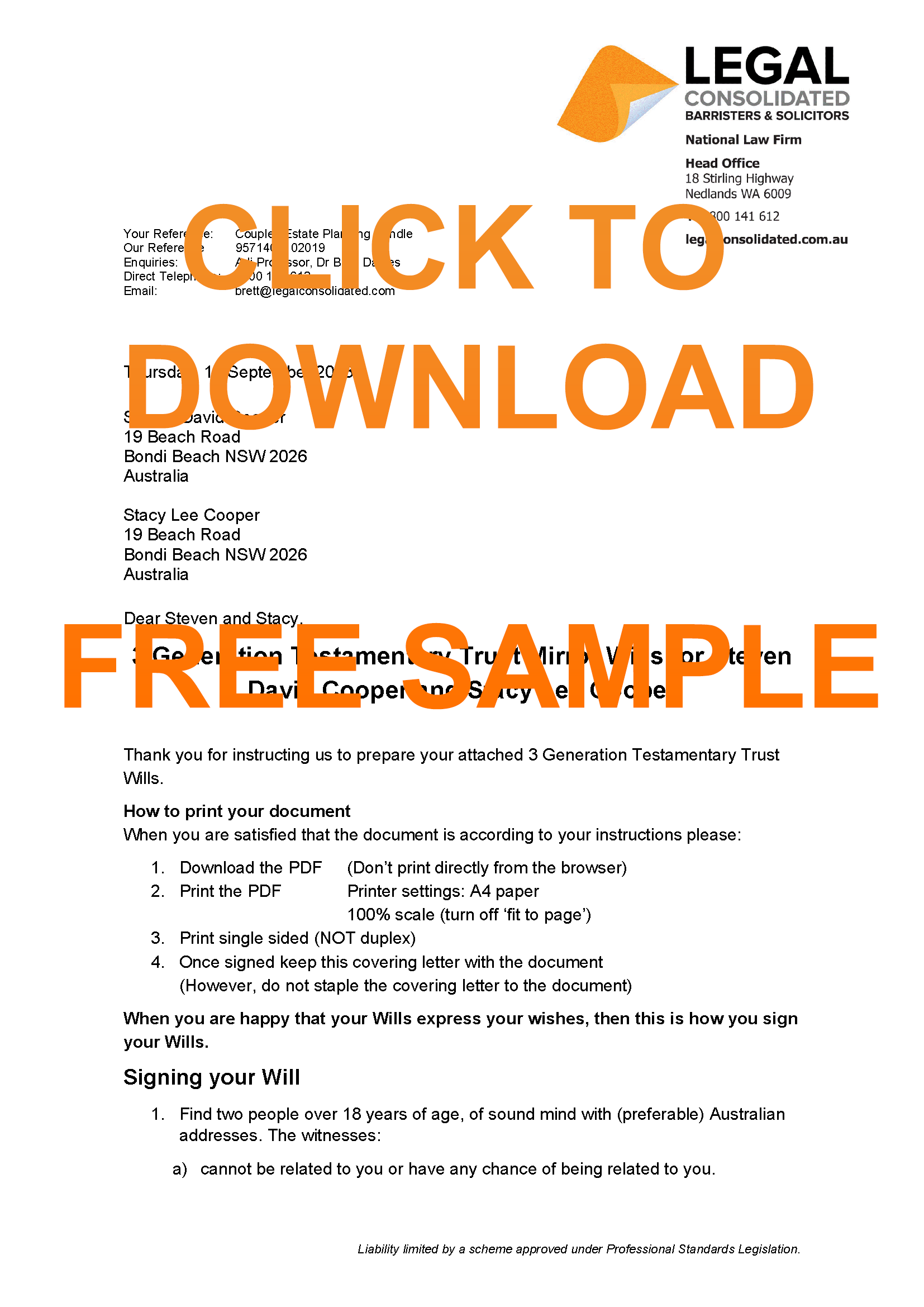What is an Investment Strategy?
An Investment Strategy is a plan for making and holding the Self-Managed Super Fund’s assets. Our SMSF Investment Strategy is designed for up to 6 members.
As circumstances change, it is important that the Investment Strategy is reviewed and updated at least annually, and the Minutes contained within this document are your evidence of this.
The law requires that all Self-Managed Super Funds have an investment strategy. This helps the trustee make decisions on how they are going to invest for the best interests of the members.
Our Investment Strategy is fully compliant with Commonwealth legislation, contains Minutes for the Self-Managed Super Fund to adopt the Investment Strategy, as well as a letter from our law firm confirming that you have built a compliant Investment Strategy.
The Australian federal government provides generous tax concessions that come from operating a ‘compliant’ self-managed superannuation fund (SMSF).
SMSF Investment Strategy compliant with ATO, auditor and Banking Royal Commission
The Legal Consolidated SMSF Investment Strategy is continually updated based on ATO desktop audits we attend. And we consider ATO rulings and Court cases on a continuous basis. When the ATO position changes (both public and private) we update the SMSF Investment Strategy.
To ensure your SMSF Investment Strategy remains current, build the SMSF Investment Strategy each financial year.
The SMSF Investment Strategy is designed to comply with the SIS Legislation, the ATO’s current requirements, the Banking Royal Commission and best practice of your SMSF auditor.
Is it acceptable to have 90% of your SMSF in one asset?
The ATO attacks SMSFs that have most of their wealth in one asset. About 17,700 self-managed super funds hold 90% or more of their funds in one asset or a single asset class. The ATO is concerned:
- Have the trustees given due consideration to diversifying their fund’s investments? If not this can put the fund’s assets at risk.
- Lack of diversification or concentration risk can expose the SMSF and its members to unnecessary risk if a significant investment fails.
The last time I checked the ATO is not licenced to give financial planning advice. Why is the ATO sticking its nose into areas for which it has no skill or permission to be in? Whether ‘diversification’ of a portfolio is appropriate is a question for your financial adviser – not a tax collector.
The ATO asks trustees to review their investment strategy to ensure it complies with regulation 4.09 SIS Regs. Regulation 4.09 asks you to consider diversification, not to be diverse. Similar to the insurance consideration, an SMSF is not required to hold life insurance. It just has to consider whether it should. The ATO asks trustees to have their investment strategy ready for their SMSF’s auditor for their next audit. According to the ATO, ‘this is to help the auditor form an opinion on the fund’s compliance with these requirements’. Sorry ATO.
Auditors have enough of a burden already. Auditors are not in the business of being financial planners – they audit.
Nothing in the superannuation law prevents your SMSF from holding 90% or more of its funds in one asset or a single asset class. Take a look at section 52B(2)(f) SIS Act. It merely requires each SMSF to “formulate, review regularly and give effect to” an investment strategy that has regard to the whole of the circumstances of the fund, including the factors set out in reg 4.09(2) SIS Regs. Now that does include though to the risks from inadequate diversification.
On the face of it, it is, therefore, perfectly acceptable for an SMSF to invest 100% of its funds in a single asset. Consider, for example, business real property or 100% in the Australian Securities Exchange. However, the SMSF trustees ensure that the investment strategy allows this. Legal Consolidated’s investment strategy does. Our investment strategy has regard to the additional risks from such “inadequate” diversification in terms of:
- the likely return from the investment having regard to the fund’s objectives
- liquidity
- expected cash flow requirements; and
- the ability to discharge its existing and prospective liabilities (e.g. benefit payments).
Diversity of the Member’s SMSF
Holding a number of investments is the essence of diversity. This may have the effect of reducing volatility. However, it is best to speak with your financial planner and accountant because diversification is only one factor to be considered in a fund’s investment strategy.
Diversification is a risk management strategy that mixes a wide variety of investments within a portfolio. The rationale behind this technique is that a portfolio constructed of different kinds of assets may, on average, yield higher long-term returns and lower the risk of any individual holding or security. Alternatively, your financial adviser may be of the view it just waters down returns.
There is higher holding costs in managing many assets. Warren Buffet says, “Wide diversification is only required when investors do not understand what they are doing.”
History has shown that diversification has not necessarily saved investment portfolios. In fact, without the aid of a financial planner, it is more likely, not less likely, that the SMSF may take a substantial loss at some point. The truth is that the fund cannot avoid losses. The fund takes losses at times in the investments, whether they are diversified or not. Don’t listen to the ATO’s ‘financial planning’ advice on ‘diversification’. Instead, speak to your financial adviser and accountant.
Disadvantages of Diversification in a Self-Managed Superfund’s portfolio
- Diversity in an SMSF reduces Quality
There are only so many quality companies and even fewer that are priced at levels that provide a margin of safety. The more stocks you put into the fund portfolio the less concentrated the portfolio is in the best opportunities.
- Too Complicated
It is possible to include so many assets in the fund portfolio that the fund does not fully understand what’s in them. Diversification in investing is important, but a simple portfolio is often easier to manage.
- Indexing
If the SMSF has too many assets in its portfolio it essentially becomes an index fund.
The more shares the fund owns the more correlated the portfolio is to stock market returns. (Which may lead to a lack of diversification.)
- Below Average Return
Indexing and over-diversification may be disadvantages of diversification because quality suffers when you own inferior investments along with good investments. Below average returns result from transaction fees or high fund fees.
- Balance assets outside of the Superannuation fund
Only the members with their financial planners have a complete picture of the overall assets of the member – both in and out of the superannuation fund. Assets in the fund can balance the assets out of the fund. If you and your adviser feel you are overweight in equities out of super – then non-equity assets in your super may be appropriate. If you want to live in the Gold Coast after retirement then it may be appropriate that your superannuation holds that Gold Coast retirement home, for the moment.
Most of my SMSF assets are in the same class – what do I give my accountant and auditor?
Q: Management Letter: I have been sent a management letter requesting minutes for the meeting detailing my investment strategy because I have a large proportion of the fund’s assets in one class (physical metals). Do I include your cover letter (first 3 pages) in this submission of my investment strategy minutes and diversification statement?
A: I would include the entire letter that our law firm gives you when you build this year’s Investment Strategy. As well as setting out our interpretation of the current rules, it shows that you got legal advice and this may give additional comfort to both your accountant and auditor. You need to provide your own diversification strategy that your accountant and financial planner help you with.
These factors in our Investment Strategies are considered:
- diversification of the fund’s investments
- the risks associated with inadequate diversification within the context of the fund’s investment portfolio
- the making, holding and realising and the likely return from the fund investments having regard to the member’s retirement objectives and expected cash flow requirements
- the liquidity of the SMSF investments, including the ability of the fund to pay benefits as members require and pay other costs incurred by the fund
- whether to hold insurance cover for members of the fund, from time to time
What is an SMSF Investment Strategy?
An Investment Strategy is a plan for making and holding the Self-Managed Super Fund’s assets.
As circumstances change, it is important that the Investment Strategy is reviewed and updated at least annually, and the Minutes contained within this document are your evidence of this.
The law requires that all Self-Managed Super Funds have an investment strategy. This helps the trustee make decisions on how they are going to invest in the best interests of the members.
Our Investment Strategy is fully compliant with Commonwealth legislation. It contains Minutes for the Self-Managed Super Fund to adopt the Investment Strategy, as well as a letter from our law firm confirming that you have built a compliant Investment Strategy. It complies with SIS Regulation 4.09 and the case of Cam & Bear Pty Ltd v McGoldrick [2018] NSWCA 110. Most auditors require this to protect them from section 55(3) SIS Act 1993 prosecution.
The Australian federal government provides generous tax concessions that come from operating a ‘compliant’ self-managed superannuation fund (SMSF).
Each financial year Legal Consolidated produces investment strategies that comply with the latest ATO rulings.
We ensure that your SMSF’s investment strategy:
- is in writing
- complies with the legal requirements and trust deed provisions
- has been implemented accordingly and documented in meeting minutes
- is reviewed at least annually; and
- any changes are documented in meeting minutes.
What does your SMSF Auditor need to see?
SMSF auditors ensure that appropriate audit evidence is obtained to show that an SMSF has a compliant investment strategy (Regulation 4.09 SIS Regs) that considers the whole of the circumstances of the fund including risk, return, liquidity, diversification and any insurance needs. Each year we prepare such Investment Strategies.
Auditors fed up with ‘fake’ SMSF Deeds
There are non-law firms preparing SMSF Deeds and variations. This is probably illegal. But they argue that they are merely reselling an SMSF Deed that they got from a law firm. Sadly, the law firm Professional Indemnity insurance does not cover these ‘resold’ legal documents. Accountants, auditors and clients are exposed. Auditors to protect themselves are requiring that you update your SMSF Deeds directly with a law firm’s website. You can do that here.
Over 6,400 Australian accountants and advisers build legal documents on our website. This is for their clients. Because we are a law firm, their client becomes a client of the law firm. Therefore, your client is directly covered by our law firm’s Professional Indemnity insurance.
In contrast, a non-law firm website:
- merely resells a lawyer’s template; and
- therefore, there is no law firm Professional Indemnity insurance on the document
Is building an SMSF Investment Strategy giving financial planning advice?
To give advice on superannuation and SMSF funds you need either a limited or full Financial Services Licence. For example, such licences are required when recommending the setting up of an SMSF, starting a pension, commutations and giving advice on an SMSF Investment Strategy.
On our law firm website for your clients you build:
- SMSF Deed – each comes with the latest Investment Strategy
- Special Purpose Company – to be trustee of SMSF
- Binding Death Benefit Nomination – updates the SMSF Deed as well
- SMSF Commercial Lease Agreement
- Deeds of Variation – Change Trustees & Members, Update Deed for new SIS Laws
- Product Disclosure Statement – fully compliant with budget
- SMSF Investment Strategy
All documents come with our law firm’s covering letter. It states that we authored the document. Not you. We are responsible for each document. Indeed only lawyers can provide ‘Deeds’.
We have been providing SMSF Deeds (with Investment Strategies) and standalone Investment Strategies, each year, since 1994.
When you build an SMSF Deed or an Investment Strategy we are responsible for the document. Not you. In our view, the providing of such documents is not the provision of advice relating to the Financial Services Licencing rules. But in any event, they are the law firm’s documents and you are not responsible for them.
Investing in Cryptocurrency using SMSF
Legal Consolidated SMSF deeds are fully compliant with the new Cryptocurrency rules see here.
Are accountants and advisers giving legal advice when building legal documents on our website? See here.
What date do you sign the SMSF Investment Strategy minutes?
Q: Signing: At the bottom of the minute’s document above the space for the trustees to sign, it says “unless stated otherwise each signature below was affixed on the date of the meeting”. In my case, the meeting took place on 28 January. However, I am now resubmitting the investment strategy purchased from you. Do I need to sign/date any differently?
A: We first produced the SMSF Investment Strategy in 1988. We update it each financial year. Therefore, you should build a new one each year. However, it is common for the Legal Consolidated Investment Strategy to be signed a number of times throughout the year. In fact, it looks good to be reviewing and signing an Investment Strategy quite often. It confirms you care about investment strategies. Date the minutes the date you sign the Investment Strategy.
SMSF’s life Insurance, Total Permanent Disability and other insurance
Q: Do I need to include an additional note for life insurance decisions in my submission for the management letter?
A: Yes, you should work with your life insurance adviser on what insurances you must hold (e.g. artworks). Everyone is different. For example, if you are a father with a stay at home wife with 5 young children you may need more life and TPD insurance.
If your accountant, adviser, auditor and lawyer decide it is necessary to have in writing, such policies or minutes then attach them to the Investment Strategy. And update them at least once a year. And more often throughout the year if your circumstances change.
Cam & Bear Pty Ltd v McGoldrick [2018] NSWCA 110
The facts of Cam & Bear
Dr Bear is a member of his SMSF. Dr Bear has a friend. His name is Mr Lewis. Mr Lewis works at Lewis Securities.
Dr Bear provides regular contributions to the SMSF. This is via cheques payable to Lewis Securities.
Dr Bear believes that from 1996 to 2008 his SMSF is in cash and shares.
Dr Bear’s auditor has a similar view. And provide unqualified audit reports, accordingly.
They stated that the financial statements fairly reflected the financial position of the Fund. The auditor did not have any direct communication with Dr Bear.
On 22 September 2008, Dr Bear directs Mr Lewis to withdraw some cash from the SMSF.
Mr Lewis is reluctant to do so. And then conveniently Lewis Securities goes into voluntary administration. There is no money.
What the court said in Cam & Bear Pty Ltd v McGoldrick
Dr Bear wins.
- Even with Dr Bear’s lack of financial sophistication, he should have considered the prudence of giving large amounts of money to Mr Lewis. Dr Bear is silly. He should have been smarter.
- But the auditor’s negligence is the main cause of the SMSF’s loss.
Accordingly, the loss is apportioned. 10% to Dr Bear’s SMSF. And the other 90% is appointed to the SMSF’s auditor.
The auditor owed a duty of care to the SMSF. This is to exercise reasonable care, skill and diligence. This is to ensure that the audited financial report presents a fair description of the circumstances.
The financial statements did not give a fair representation of the affairs of the SMSF. Therefore, it is incumbent upon the auditor to either:
- qualify the report;
- or bring to the SMSF trustee’s attention to the problem.
Ryan Wealth Holdings Pty Ltd v Baumgartner [2018] NSWSC 1502
The facts of Ryan Wealth Holdings Pty Ltd v Baumgartner
The Ryan Holdings Retirement Fund lodges three financial returns. These are for FY07, 08 and 09.
The Ryan Holdings Retirement Fund is established. It invests in loans to various entities and investments in unit trusts. Sadly, the professional adviser has a personal interest in some of these investments.
The SMSF financial statements show these as ‘mortgage loans’.
- But there are no mortgages. The information provided to the SMSF auditor contained no evidence of any mortgages. There is no registration of any encumbrances over any of the assets.
- The auditor fails to try and find that evidence of a mortgage.
In all 3 financial years, the auditor merrily gave the SMSF unqualified audits.
The SMSF argues that the auditor failed to check on the mortgages. And, therefore, they went undetected.
By the time the SMSF found out that there are no such securities it is too late.
Decision of Ryan Wealth Holdings Pty Ltd v Baumgartner
The Court states that the auditor fails to exercise reasonable care and skill:
- this is to ensure that the investments are valued at net market value
- fails to exercise judgement in assessing the reasonableness of the disclosed values
- the auditor has a duty to report to the SMSF about the obvious conflict of interest of the professional adviser and the high level of risk associated with the loans and investments.
The Court assesses damages of $2,260,140.
The Court looked at the chances of the unsecured loans being paid back.
Responsibility for the loss is apportioned 10% to the SMSF. And 90% to the auditor. Further, the Court states that the SMSF’s loss is apportioned to the professional adviser as to 20%.
What do we learn from Cam & Bear v McGoldrick and Ryan Wealth v Baumgartner?
It is a tough year for auditors.
But these two cases, Cam & Bear and Ryan Wealth Holdings highlight, not only highlight risks to SMSF auditors. They are also warnings to financial planners, accountants and lawyers.
6 best practices to follow for an SMSF’s financial reports:
- Work out who is the key contact at the SMSF. That person sees all communications. This is particularly where instructions are being provided by another person. Whatever the accountant, financial planner and auditor state should be cc’d to the key contact. And when in doubt email all members of the SMSF (and the SMSF’s corporate trustee, if a corporate trustee).
- In your instructions make it clear to your client, the SMSF, that you are not doing certain things. For example, the accountant preparing the SMSF tax returns is not an auditor. The accountant does not test the information provided. But still, point out problems wherever you see them.
- Mistakes and errors are common. To err his human. When they are uncovered be ready to engage the ‘team’.
- Only lawyers can give legal advice. Only accountants can deal with certain matters. Only a financial adviser can give financial planning advice (e.g. reversionary pensions). If you stray out of your professional area your insurance stops. Work with your team.
- Emails and a chain of emails is good insurance.
- Sack clients that are on the edge, lie to you or want you to lie. The first person to dob you in is your client when a regulator comes a-knocking.
Click here for all the documents you can build online at our law firm.
Email us with a question or for legal advice.
Business Structures for Personal Services Income, tax and asset protection
Family trust v Everett’s assignments
- Family Trust Deed – watch the free training course
- Family Trust Updates:
- Everything – Appointor, Trustee & Deed Update
- Deed ONLY – only update the Deed for tax
- Guardian and Appointor – only update the Guardian & Appointor
- Change the Trustee – change human Trustees and Company Trustees
- The company as Trustee of Family Trust – only for assets protection?
- Bucket Company for Family Trust – tax advantages of a corporate beneficiary
Unit trust vs Everett’s assignments
- Unit Trust
- Unit Trust Vesting Deed – wind up your Unit Trust
- Change Unit Trust Trustee – replace the trustee of your Unit Trust
- Company as Trustee of Unit Trust – how to build a company designed to be a trustee of a Unit Trust
Corporate structures and Everett’s assignments
- Partnership Agreement – but what about joint liability?
- Incorporate an Australian Company – best practice with the Constitution
- Upgrade the old Company Constitution – this is why
- Replace lost Company Constitution – about to get an ATO Audit?
- Independent Contractor Agreement – make sure the person is NOT an employee
- Service Trust Agreement – operate a second business to move income and wealth
- Law firm Service Trust Agreement – how a law firm runs the backend of its practice
- Medical Doctor Service Trust Agreement – complies with all State rules, including New South Wales
- Dentist Service Trust Agreement – how dentists move income to their family
- Engineering Service Trust Agreement – commonly engineers set up the wrong structure
- Accountants Service Trust Agreement – complies with ATO’s new view on the Phillips case











